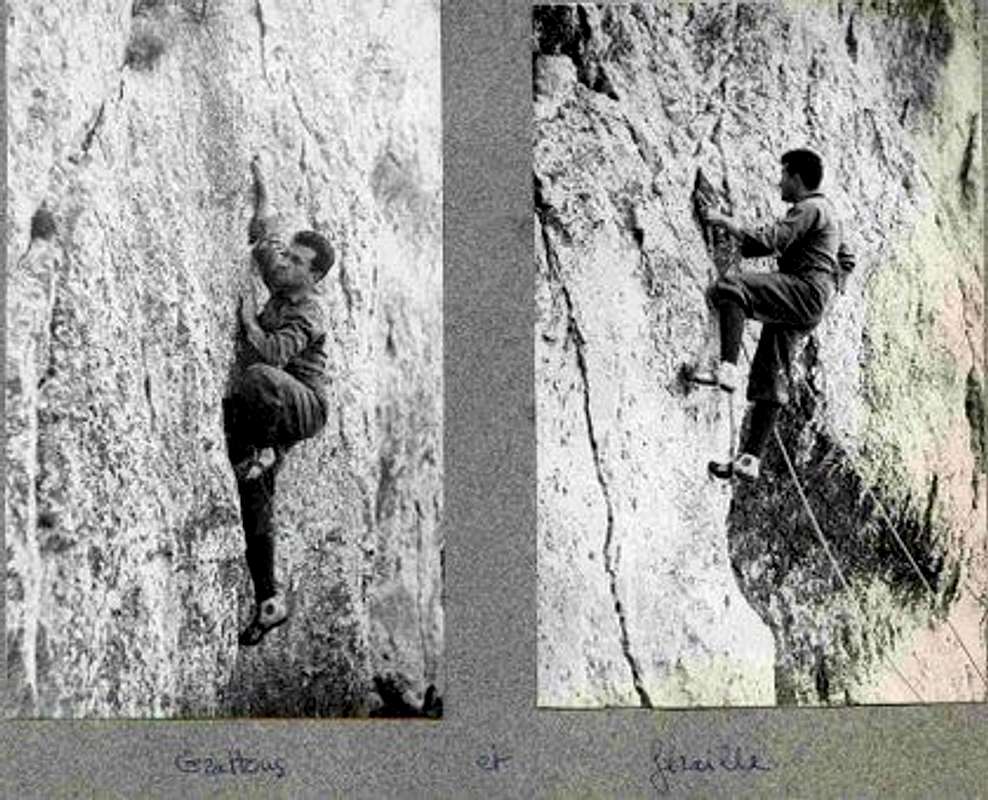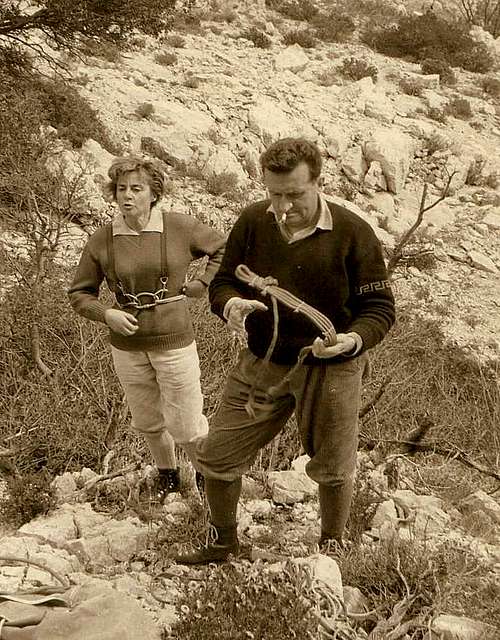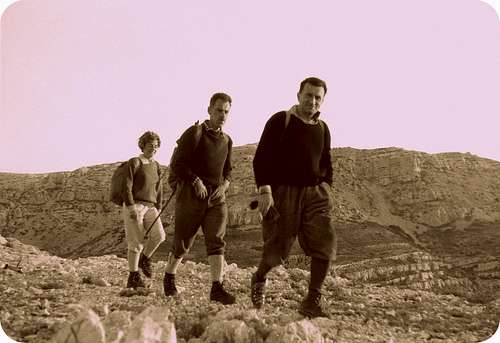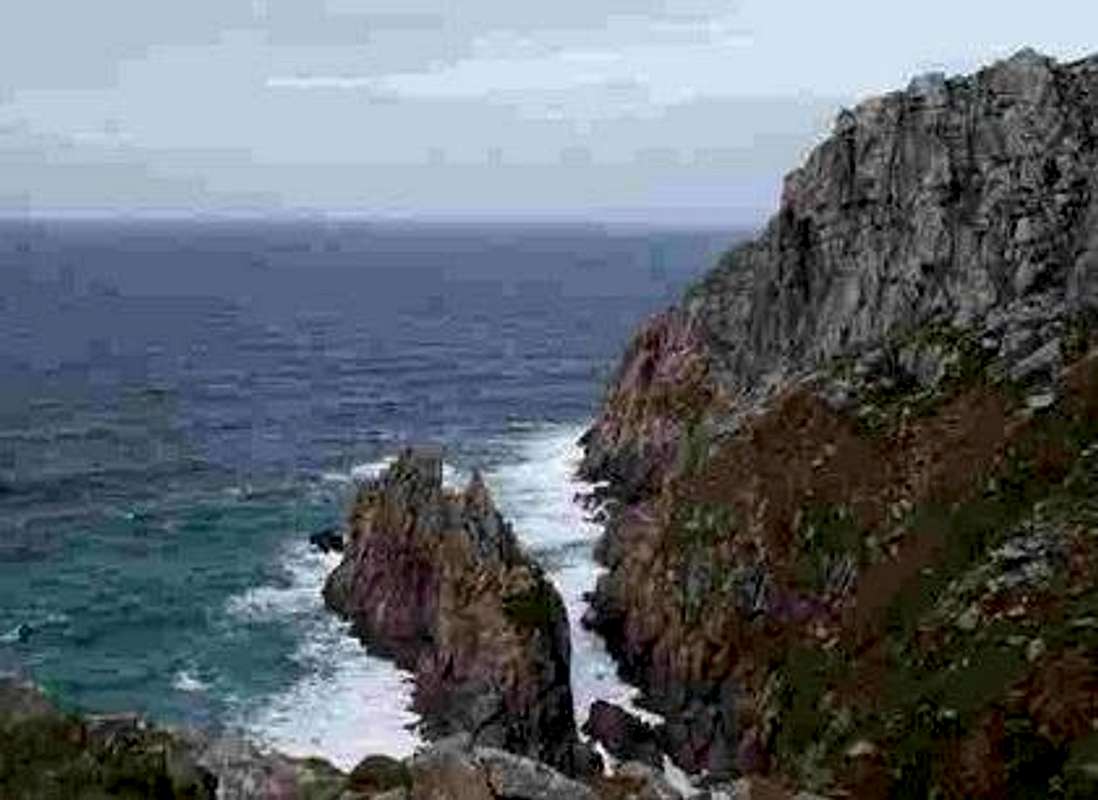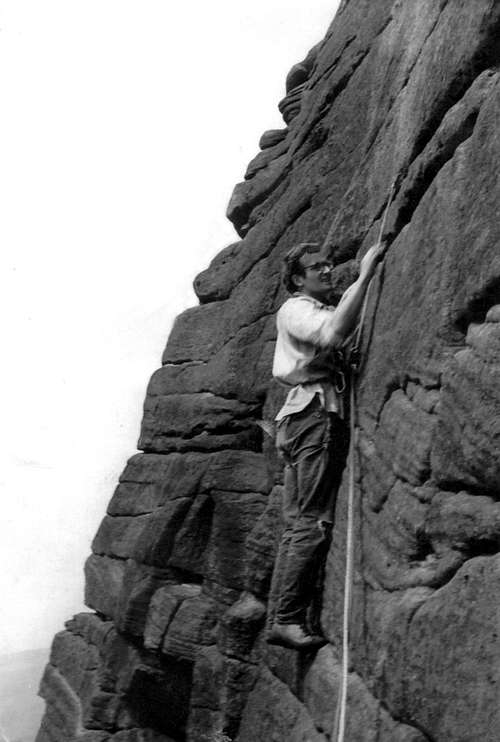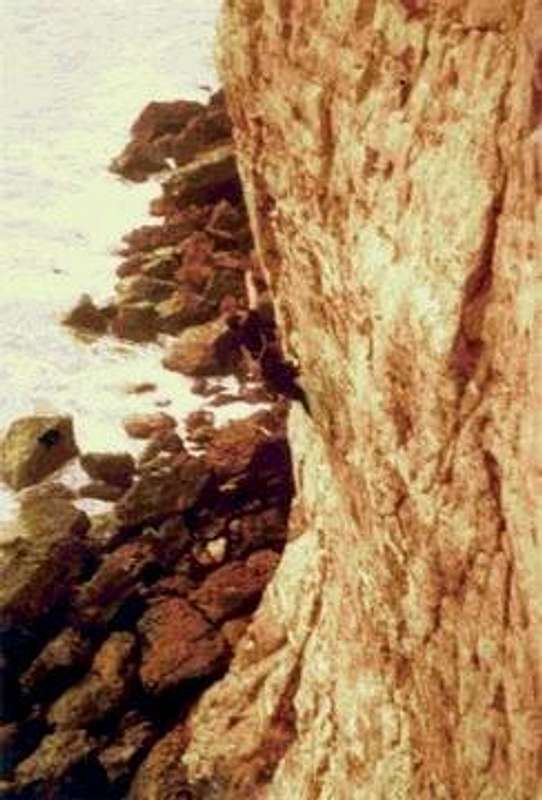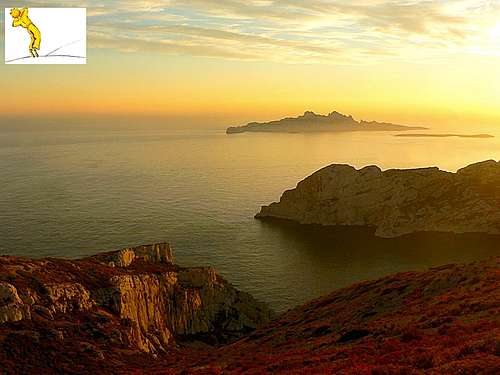PART I -NEW WAVE - IN THE CALANQUES
A STORY OF THE OLD TIMES BY GEORGES LIVANOS (“Le Grec”) and Eric VOLA

Sonia, Baffo (Roger Lepage) and Le Grec (photo E.Vola)
From the beginning of the 1950s to the end of the 1970’s, Georges Livanos, “Le Grec” (The Greek) was “The king of the Calanques” and an “Emperor” of the Dolomites with more than 500 first ascents in the Calanques and 40 in the Dolomites and the Alps. Born in 1922 from a Greek father he was 100% from Marseille and loved to act his own role, that of colourfulness and humour at its best. Many of the great names of French Alpinism shared a rope with him: Lucien Devies, Jean Franco, Maurice Herzog, Lionel Terray, Gaston Rébuffat, Jean Couzy, Michel Vaucher, Claudio Barbier, Robert Paragot, and Lucien Bérardini. And then there were his Italian friends such as Gino Soldà, Armando da Roit, Beppi de Franchesch, Marcello Bonafede, Menegus, Stenico and many more particularly when they came climbing in the Calanques.
“The Greek” wanted to become a tough guy in the climbing world; for him the Calanques were a springboard to go farther, in the mountains, on big walls. Until 1956, Robert Gabriel was his rope mate in a great number of first ascents on the breathtaking walls in the Dolomites, then, besides Marc Vaucher and Roger Lepage who climbed with him until he stopped. His wife, Sonia, became his ideal partner, always ready to follow him on the 1200 meters of the North face of the Civetta or on the Grand dihedral of the Cima Su Alto. Unlike « professionals » and today’s young stars of the climbing scene, he climbed solely during week-ends, which in those years started on Saturday afternoons –there were no 35 hour weeks then - and during his summer holidays which were a maximum of 4 weeks . “The Greek” used public transport. To climb the Bertagne peak with Sonia and his friends, he took the tramway to Aubagne, then the bus to Gémenos and finally walked to the foot of the wall. To go to Chamonix he took the railways, and he drove a Vespa to go to the Vercors. This was the vehicle he used for his work as a sales rep for printing materials, and with which he travelled up and down the Bouches du Rhône, the Var and Vaucluse for 10 years. When his pal Robert Gabriel stopped climbing in 1956 (compelling order from his newly wedded wife), he found a new rope mate, Marc Vaucher, who had a Citroen DS. At last he could enjoy the comfort and time-saving that a car offered you.
“The Greek” never learned how to drive just as he also never learned how to swim. For a guy from Marseille, that really takes the biscuit! He boasted that he was « a Sunday climber » and not a true « sportsman » like the young stars of today working their way through the 8th and 9th grades! Despite this, his list of ascents is amazing even today, and above all, what high quality: Oh man! The Livanos routes! Repeating them was enough to convince yourself that you were among the top climbers! They were a must: "The one who did without bivouac the Livanos pillar at Archiane could consider the big North walls…" (Bruno Fara, Climbing years 1970), that is in the Vercors as in Dolomites, then, in the 1950s and 1960s, there were very few French climbers there.
This is how he concluded his scoring at the end of 1978, when, aged 55, he stopped climbing after 40 years of activity:
- Calanques routes 134,500 m
- Various attempts 10,750 m
- Chamonix 8,900 m
- Oisans 6,600 m
- Bregaglia 1,500 m
- Training Crags & Verdon 15,860 m
- Dolomites 64,000 m
- Total of 242,100 m
- Hours 8,900
- Pegs 25,000
- Abseils 1,450
- Calanques 630 different routes (500 first ascents and 1660 climbs)
- New routes Calanques & Mountains: 56,160 m
- 60 "1st" (32 of 6th grade - 38 abroad)
- 91 bivouacs
"I climbed with around 300 guys, e basta" - "For me the ideal is to start from the bottom, reach the top and come back down. And not too fast..."Au delà de la Verticale - Arthaud 1958 & Guerin 1997".
“The Greek” is remembered as the most humorous and best liked French climber. He wrote the ultimate humorous French mountain bestseller, which was unfortunately never translated into English. He is also the only non-Italian to have received with his wife, Sonia, the Pelmo d’Oro and with Sonia, he is considered officially as one of the greatest Dolomite climbers by the Italian Dolomite climbers.
The story below was written in the bulletin of the club he created in Marseille, The GGM (Groupe des Grimpeurs Marseillais), was a sort of local GHM alongside the French Alpine Club. It is about a climb we did together and it is followed by a report of what I was doing a few months after on the British rocks to keep them informed of the extraordinary behaviour of the “Grand Bretons” (which we then called the Rosbifs).
NEW WAVE - Bulletin G.G.M.[1] 1961 - by GEORGES LIVANOS
If “The Greek” has not yet reached the shore, I was going to say « the last shore », it is obvious that he is nearing it little by little (as are we all!) and it seemed that a dead calm would land him on sandy beaches, under the vertical, (preferably near Tahiti and with the accessory contribution of some lovely Tahitian girls for local colour…) but a buoyant New wave appeared on the horizon. That the Greek has a nerve is indisputable. For the beginning of a story in such a seascape atmosphere from a guy who does not even know how to swim (in the literal sense), is like soloing up the Eiger, blindfolded and wearing boxing gloves.
But let’s come back to this New wave of which Eric Vola (with such a name, personally, I would be careful…[2]) is one of its brilliant representatives. I know there are others, but hazard and affinity pushed me one day to propose to climb “something” together. This “something » was the Ecaille (The Flake) route at La Mounine[3]. I had climbed it twice some ten years back, and I was eager to see it again.
We arranged a rendezvous at the Grotte Rolland’s bistro for one Thursday morning. (Yes indeed, the representatives of the New wave and the plain representatives[4] themselves have such opportunities). During our approach march, I realized that Eric is a swell chap. Indeed he seemed to know thoroughly one of the masterpieces of mountain literature…[5] unless he learned a few bits rapidly that same morning which he used wisely afterwards in our conversation. To get to the foot of the wall, we went first to its top, a sluggards’ way to cut short our return. Our climbing harnesses loaded with pegs, and Eric’s stomach and pockets full of various provisions, we skimmed to the start.
After a minor dubbing ceremonial the new wave dashes up. He goes up with great ease but, would he be pushing the respect due to old glories to the point of fearing to impose on them the humble task of the unpegger? The leader is already 20m above the ground and I advise him sharply not to fuss and so he condescended to put a peg in. Another a bit higher and he reaches the first belay. Obviously two pegs for those 30m in which HVS is plentiful, is no luxury! My turn! The first peg is of the tough kind: it cost me half a litre of sweat! If they are all of the same calibre… It won’t take long for my opinion to change! Oh Yes, man!
I joined Eric at the belay. The chocolate bar which he had put in one of his back pockets is quietly melting, and as quietly he swallows it in one gulp and starts off again for the next pitch which he gets up in the same casual manner. Everything is hunky dory, I get up to him, bypass him and soon we reach the platforms below the upper part of the wall. Normally we would expect to take a chimney a bit further on, a “small HVD », but I had often looked at a long crack which would be much neater. Why not treat ourselves to a variant? Of course Eric agrees, but who was to take the lead? We played heads or tails with a karabiner and the draw designated my companion. The heat was such that I was not unhappy. Eric was delighted, but: “If you still want to take the lead…? (Once again respect for old glories) « If you go on saying “vous”, I will definitely take the lead and screw in a series of pegs that will make you sweat! » This time, no need to say it again!
A few meters of free climbing and then pegs come into action. Obviously Eric does not have the same ease using pegs with aid climbing. It is the sort of manual work which can only be learned little by little, even if it is easier than free climbing. One hour of effort and I start to play again. For me, it is a piece of cake, it’s un-pegging “with the cap”, no need for a hammer, and if you miss the peg, the puff of the cap stroke is enough! The pegs are slowing me up so little that I go up at the speed of free climbing! What a guy! He does an A3 on an A1 pitch! (But poor chap, what you are supposed to do is the exact opposite!)
I take over the lead and soon we reach the stance at the foot of the crux. It is a long, varied and tricky pitch ending at an exposed belay, so I reserved it for myself; for my seventy little Greek kilos would made a nice cap stroke on belay pegs labelled Eric! The white rock emits a staggering heat, to the point that you would think you were in an oven! The first few metres are laborious but I regain self-control and, stimulated by the presence of the New wave, I execute a recital of free climbing of which I am not dissatisfied (the old guard is not yet completely shrivelled…)
Nasty surprise: the pine tree at the belay has disappeared and we have to make it on aiders. Consequently, I take great care with the pegging, it is an installation … quite Greek, and that says it all!
Eric comes up, without much problem with the unpegging. It is true that several were in place and I do not insist that he takes them out… He does not insist either. The lack of comfort of this belay forces him to stay suspended in his aiders below me. Last pitch without any problem, though it starts with quite a tricky move to the side of a flake. It would be a pity to let that fall onto a second with such a brilliant future. The future of the said second darkens strongly when he attempts to take out the first peg of the Greek’s installation. Twenty minutes to extract this peg (and in what a state…), ten to break the second, no hesitation to leave the third, and soon after we reached the top.
To the Rucksack and « to drink »! For Eric it is more “to eat”! He swallows a camembert as others would swallow an aspirin!
Our first outing went well. There will be others; for if Eric still ignores many things, I am starting to forget many. In contact with him, I learn again that one must dare; Eric for his part, learns that it is sometimes good to hesitate. In other words if we climbed together, I would improve and he would worsen? Climbing is a question of balance… Motorbikes also, isn’t that right Eric?[6]
G. LIVANOS[1] GGM : Groupe des Grimpeurs Marseillais, plus couramment Les Grandes Gueules Marseillaises !
[2] Vola in French climbing slang can mean « has taken a fall ».
[3] A nice route in Les Calanques.
[4] At that time « Le Grec » was a rep for office equipment.
[5] Meaning his book « Au-delà de la verticale » (Beyond Vertical).
[6] 2 months before, I had broken my wrist in a motorbike accident.
Photos with GEORGES LIVANOS in the CALANQUES
Dedication from « LeGrec » on his book: CASSIN il était unefois le sixième degré (Once upon a time the Sixth Degree)
To Eric Vola
And also, as the things in “er” are many, but… no; I do not want to get into trouble with his charming Esther, so I had better stop. In memory of some nice climbs on which we didn’t break our necks, but cracked our faces from one ear to the other! With all my friendship.


In the early sixties, the « New Wave », studies mandatory, had gone climbing in the Rosbifs’s lands, abandoning with much regret, the Wednesday GGM meetings at La Plaine’s bistro[7] (where he would gulp an entire soft sheep’s cheese of 400 grams without sharing it with his pals - no bounty to the creepy ones!) and abandoning also with some regret the Greek and his witty eloquence worthy of Pagnol[8].
There, pegs were “forbidden, horrific, shocking”. Putting a peg on a climb which was first climbed without one meant life exclusion from one’s club and « the club » is for a « Grand Breton », (a Rosbif, man!) a hundred times worse than being dumped by one’s wife or girlfriend or being transported to the colonies, or both simultaneously. Only « slings » were used (sometimes around a stone jammed in a crack or an hexagon nut bought at an ironmonger’s as on the photo) while eccentricities such as night climbing wearing a dinner jacket on Cambridge college walls and other whatnots were considered not only normal but essential to join a club!
Let me tell you a short story about what happened in 1962 while I was in Cornwall. My climbing partner was an excellent British climber, Gunn Clarke (the first Brit to repeat the Walker spur in 1959, a day before Don Whillans), who was coming back from an incredible adventure on Mac Kinley, when during his return trip, he was run aground on an islet on the river he was descending, and was stuck for 3 weeks before being sighted by a plane looking for him (But that has nothing to do with our subject!). With us was my girlfriend, Esther, who later became my wife (and still is, even if it seems incredible to many, including me, but that has also nothing to do with our story!) We were climbing on a wall of superb granite, above the sea, the Bosigran Wall. The previous day we had climbed “Suicide Wall” (there are quite a few “suicide walls” on the British cliffs and obviously one must be quite wary of them). This was a climb where the second pitch was particularly risky: after 20m of a nice “layback”, one must do a “foot-hand pull up” to catch a good hold which gets you over the crux; a short move of 5b, but without any protection at all from the belay (nuts and friends did not exist yet).
A party which we had met had shown limited capabilities on an HVS route, particularly the « old guy » of the two (he was 40 years old which for me was equivalent to an advanced decaying state, except for “The Greek” of course! But everyone is not as exceptional!). I was leading Esther and an old geezer, an old Francis Chichester team mate, who had a Rolls Royce from before the war (the first one that is) which he was using as a hen house and who wore sea boots instead of the classic EBs of the climbing gents of those islands. We were on a ridge of an islet facing the Bosigran Wall. I nearly had to use violence to prevent the old geezer taking the lead. At the belay of the second pitch, while I belayed him and Esther, the ex-Chichester’s team mate doing uncontrolled skids all the time, I saw the two blokes we had met the previous day starting “Suicide wall”.
- Look at those f***ing… buggers…! I told Esther.
I hope at least that the youngster will lead the second pitch. I reached the top of the islet and had Esther come up when I saw the “old bugger” starting the second pitch. I said to Esther:
- This one is going to get it!
When he got to the crux, I told Esther:
- Look, he is about to fall!
And it happened a few seconds later. Bad luck, the first pitch is not vertical: 40 m fall and he hits the wall violently. He died one hour later.Nevertheless, our outing ended well, with the looting (legal in the islands of the Grand Bretons, licensed wreckers) of a Belgium trawler which, in a storm, had crashed into the only inlet along 20 km of coast. The crew was rescued during the night thanks to a cable thrown down by Land's End villagers from the cliff overhanging the creek. Our “efficient” “Anglo-French” party went abseiling to the trawler at low tide the next morning. For the first time I was going to be able to smoke Saint Michel’ cigarettes (and for more than a year!) from the cases we salvaged. Gunn had seen the trawler navigation equipment and typical of a Cornish wrecker, suggested we should come back the following day with tools to take it off, hoping that the money we would make selling it to the ship’s owner would cover the costs of a trip to the greater ranges. So off we went again, but the local villagers had been faster than us and everything was gone. From frustration I told Gunn that I was going to dive into the trawler to reach the crew quarters using a hose I found nearby. I was hoping for “Whisky Galore”, but I only salvaged one bottle of Pastis and a box of 5 dozen eggs! However I had swallowed so much Diesel oil that I could hardly speak for a full week and as the high tide had submerged the trawler and me, Gunn had to throw me a rope to drag me out of the sea to the end of the abseil rope which I got up by prussicking, thoroughly wet and with a burning throat. Gunn was a pleasure to climb with, you could count on him at all times particularly on ship wrecking trips! But once again, this is another story.DOVER CLIFF and MICHAEL GRAVINA
Two weeks later, with another British climber from Cambridge this time, Michael Gravina, I was attempting a first ascent on a Dover cliff (Michael was the youngest son of “Briggsy “– Countess Dorothea Gravina – distinguished member of the Ladies Alpine Club who had participated two years before at the first all women Himalayan expedition to Cho Oyu under the leadership of Claude Cogan who died in an avalanche with Claudine Van den Straten).I had met Michael at an annual diner of his Cambridge alpine club during which we had as a guest star, Mr Marples the then transport minister at a time (1963) when stickers flourished on cars windscreens with “Marples must go”. Probably they disliked his manner of driving a bicycle when going to Westminster instead of using a car or public transport. After the toast to the Queen he made some joke about “Marples must go climbing” much appreciated by the audience. We ended with what I was told to be a typical Cambridge Alpine Club practise: night climbing in our dinner jackets on the University buildings but in proper EBs. I tore my dinner jacket pants which I had borrowed on one of Jesus college walls. That night Michael told me that he had heard about my “talents” as a pegger from the Calanques and on this cliff, pegging was authorized! The fact that I also had a grandfather who was a count appealed to Michael, which was inappropriate as he had lost all his properties and money gambling and with women, becoming the pet peeve of the family. Furthermore, my grandfather’s signet ring that my mother had given me after his death being the elder male in the family kept on jamming in cracks, so I lost it purposely and in any case I had adopted my father’s commoner’s revolutionary ideas. Whatever, Michael had decided to take me with him as his leader. First pitch, nice free climbing without any problem and quite a nice belay. The second pitch looked more difficult. Pegging starts. On this highly crumbly rock, I started again what The Greek has described in detail on the Ecaille (The Flake) route. I do A4 while it should have been A2 (“But poor chap, it is the exact opposite of what you are supposed to do!”). I am 20 m above the belay and at about the same distance from the end of the difficulties when the peg on which I am standing snaps and I « unbutton » the whole pitch! The wall is overhanging so I fall into the void without touching the wall, like a butterfly. However, the Rosbif on duty who was belaying from his belt, as Rosbifs always did then, was thrown against the wall and found himself with a huge black eye on his face. Despite all my efforts, badly hit by an acute jaundice, he refused obstinately to let me re-peg the pitch and so this first ascent failed and once again I disappointed “The Greek”, my Master es-climbing.However, it was not a complete disaster. My belay was worthy of him: you could have attached an aircraft carrier to it![1] I must say, Michael was quite a gentleman! On our way back to London he asked me if I wanted to drive his Mini minor van and I said yes. Not a minute later, on the highway, I pulled out of my lane to overtake a car while a powerful Bentley already overtaking nearly pushed us out of the way! Shaken for the second time and furious, Michael ordered me to stop and learned that I did not have a driving licence and that it was my first driving lesson.
This did not prevent him to have several climbing adventures with me and his newly wed Muriel in the Alps. However, the last one was to be this time truly the last. Overtaken by a huge storm on the Rébuffat route on the Aiguille du Midi while dressed in just shirts, suddenly in the middle of the slabs the route became a very steep snow one. Soon after our shirts were frozen stiff, while I was cutting steps and getting up on my ice axe jammed in cracks. On the last pitch after the small abseil in the North side, on the last peg, trying to get my weight up, I “unbuttoned” again all the pegs in the crack and had a good 30+ metres fall. The eye of the belay’s peg broke but the karabiner and the rope stayed in. Quickly I climbed back to the belay and replaced the broken peg with one of the “unbuttoned” pegs. Out of breath from the fall I required a bit of time to come back to action. This is when Michael started calling Briggsy for help. To stop him lamenting and restore some hope in him I forced him to climb up the abseil to get its peg out to replace the one peg we were now missing to get out of this last crack. It all worked out swell, but that was the last I saw of Michael… Maybe he was tired of a climber “unbuttoning” peg pitches once too often!
[1] One of the typical expressions of The Greek. Among others: "Better one more peg than one man less… especially if that man is me!” or “One day, I had myself written to Robert Paragot : "When you have hunted lions, rabbits look meagre." And I will quote Robert Gabriel: "If I killed myself in the Calanques or one asy ground, I would not dare go out any more". And: “There is no bad rock just bad climbers”. “Great daring make small careers.”
THE IAN MAC NAUGHT DAVIES A, B, C, D CLIMBER's SCALE.
Recently Chris Bonington married Loreto Mac Naught Davis, Ian's widow. I had been Chris's second best man at his wedding with Wendy in 1962 and two winters back I organised an oyster and skiing party at Les Suches (2 200 m La Thuile - Italy) at the chalet of Ruggiero Montesano, a friend of Walter Bonatti at which Chris and Loreto declared their love. Later when they announced their wedding, I reminded Chris a meeting at Harrison Rocks way back in 1963 where he had taken Ian with him who had told us of his A, B, C, D climbers' categories theory in his usual very forceful and convincing way. Funily Chris had lost memory of it. Here it is:At the time, Ian did impressed us, he was a generation older, had done the first ascent of the Mustagh Tower with Joe Brown, Tom Patey and Jon Hartog, was already a top boss in computing software, was immensely wealthy compared to us, drove a brand new smooth 6 cylinders Triumph 2000 sedan which was quite a change from the Mini Minors we used to drive in. His words were listened to, including by a frog like me lost in the Rosbif lands. I have always remembered his A, B, C, D theory for its simplicity and its spirit, typical of the British climbers of the time. Chris has been a lucky man to have him as a friend, not to mention Loreto Herman.The A climber climbs everything speedily and with obvious ease. The B climber climbs everything but sweats.The C climber climbs everything but struggles badly.And then all the others climbers fall in the D category.POSTSCRIPT: WITH DON, MARTIN and THE BOYS.
I cannot end this story without something about Wales and its stupendous crags. I can’t remember how but while in the Pass’s pub, Don Whillans invited me to climb on Cloggy and off we went onto this magnificent slab, Bloody slab. Don, leading, stopped about 10 m above the ground and fiddled around to put a sling to protect himself. When he was 5 metres above it, it just fell off! Don continued up to the top of the first pitch without a single protection. The climbing was superb and for the first time I discovered that on slabs, small guys like Don had a neat advantage on tall ones with their balance. I was so impressed by Don’s “solo” climb of the first pitch that I forgot the belay sling. Furious Don told me to go down the second pitch to get it, which I did. When we reached the top of the third pitch and top of the climb, Don saw that again I had left the belay sling. This time, obviously thinking that I had not been fast enough descending the second pitch which although not as difficult as the first one was not that easy to reverse, he unroped and went down to fetch it. 10 minutes after he was on top again. I guess Don did not appreciate this absent-minded frog leaving behind some of his highly precious equipment. Slings were not sold by the pound onto the local markets similarly as with the pegs on the Marseille’s ones! [10]
We never climbed together again, but luckily others took over, and among great fellows such as Chris Bonington and Nick Estcourt - Ah! Nick's brutal show of strentgh when knee jamming in the horizontal crack of Maltraverse on the Avon Gorge - And there was Martin Boysen, the superb cracks and slabs’ climber, whom I followed the following day, as he reminded me recently, on a nice first ascent in the Pass, a climb called “The Monster” which has a different name now as he told me. Martin led it beautifully, with protections though, but he was as superb a climber as Don. Great times with great boys, but one thing for sure, If I missed my British climbing friends' excentricities (which I kept imitating quite forcefully when back on the continent) I never missed the Rosbifland's constant rain.
E. VOLA
Last note: One day in 1964, in the HQ of the British Army of the Rhine, one British NCO hailed me:
- Hello Frog! to which I replied:- Hello Rosbif! - But why do you call me a Rosbif?- And why do you call me a Frog?- Because we call Frogs all the French!- Well, we call Rosbifs all the British!A point of history in Anglo-French relationships that truly flaggergasted the chap.[7] A popular square in the centre of Marseille.[8] Most known Marseille writer and film maker.[9] One of the typical expressions of The Greek. Among others:
- "Better one more peg than one man less… especially if that man is me!”
- “One day, I had myself written to Robert Paragot : 'When you have hunted lions, rabbits look meagre. And I will quote Robert Gabriel: 'If I killed myself in the Calanques or on easy ground, I would not dare go out anymore'".
- “There is no bad rock just bad climbers”.
- “Great daring make small careers.”
[10] My wife Esther has kept a high opinion of Don. Contrarily to his somewhat rough reputation, he was always very attentionate and polite with her, even charming. That could surprise some British climbers who have known Don, but for her, he was a true British gentleman, at par with Chris or Martin.
Photos in Rosbifland
In those years, I believe I was the only French climbing all the year round in the UK and so I discovered the EBs used by the British climbers on all their crags, while in France slim soles invented by Pierre Allain were only used on the Fontainebleau sandstone boulders. Maybe my service time which occurred immediately after I left the UK...
- attached to the French liaison to the Northern Army of the Rhine run by the Brits – a happy time with the NAAFI considering Pastis as a fruit juice which meant that I could buy quite a few bottles at a bargain, smuggle them in the boot of a captain’s car from the French-speaking Belgian Army to cover the costs of a week-end in Brussels with the girl-friend who became my wife; and with so many eccentric British characters such as the camp commander, a full colonel named James who owned an Aston Martin with a 007 on his plate as well as on his Nato pass, or the whole Commander in chief headquarters celebrating in full dress uniforms and long dresses for their ladies the 14th of July with us the four French of the liaison, even letting two of us stand on the roof of the Commander in chief’s Rolls Royce to drink champagne and throw our empty glasses on the lawn among their applauses -
... blurred my mind as I totally forgot about EBs and started again climbing in sturdy mountain books, but on the Fontainebleau boulders. It is only years after that I discovered that EB were the initials of Edmond Bourdonneau, the shoemaker Pierre Allain contracted to manufacture his famous PAs and that while Pierre was a great climber and great climbing equipment inventor, he was a poor businessman. Pierre had not taken a patent for selling his slim soles, so Emile started selling them in the UK around 1959 to his sole benefit under his initials, EB. He made a bomb as in a few years all British climbers were using them, increasing the level of rock difficulty achieved to an unknown level. I will give just one example of the rock climbing supremacy of the best British climbers then: in 1967, Martin Boysen did the second ascent of the South face of the Fou, then considered as the most difficult rock route in the Alps, freeing most of the route and the key diagonal cracks, using less than a third of the pecks used by Hemming and Harlin and nearly twice less than François Guillot who did the fourth ascent freeing also the key pitches. François at the time was among the very best French rock climbers. The difference came from the fact that Martin using EBs (PAs for François) was also using the first nuts, totally unknown in France. This impressed so much the French climbing community that Lucien Devies, the "pope" of French alpinism mentionned Martin in his Montagne et Alpinisme climbing's chronicle as a "climber of an exceptional class."
While a limited number of French climbers such as François Guillot, Jean Afanassieff, Patrick Cordier, Joel Coquegniot, did use PAs on a limited hard rock ascents in the Alps before 1970, It is only in 1975, when my friend Claude Deck organised with the BMC and the FFM a series of venues of some of the best French climbers, climbing mainly in Wales that they discovered that the EBs (and so PAs) were perfect to climb on crags and not just sandstone boulders. I participated at the first venue with superb climbers such as Patrick Cordier and Jean Afanassieff, but it is only during the second one to which Catherine Destivelle participated that the brain shock wave occurred. The brain of Jean-Claude Droyer that is. He understood the benefit it had given to the British rock climbers over the past 20 years and applied it on the Verdon’s walls, opening the first French 7 route, weeks after his return in France. Another benefit was that Le Vieux Campeur (fast becoming the leading climbing sport shop in France) asked him to become his lead PA salesman for France. A good job that Jean-Claude kept until retirement enabling him to test Le Vieux Campeur climbing shoes on crags everywhere.
As for Patrick Cordier, he did the following year (1976) the first solo ascent of the Fou South face, using the nuts given to him by Yvon Chouinard in 1973 after his solo ascent of the Nose (with a damaged arm - 3rd solo ascent and 1rst French one). As he stated later: "« Our law (ethics feels conceited) was to dicover nice lines and go with three nuts in our pockets (I exagerate, but not much). No hammer, no peg, no bolting device, no spit, no track - not seen, not taken - to live happy, let's live hidden - we called that free climbing." Rapidly the level of free climbing in France caught up with the British who had climbed for some fifteen years at a much higher level than on the continent. All this due this time not to the "perfidious Albion", but to a“perfidious” French, Edmond Bourdonneau. Blast!
External Links
Add External Links text here.


